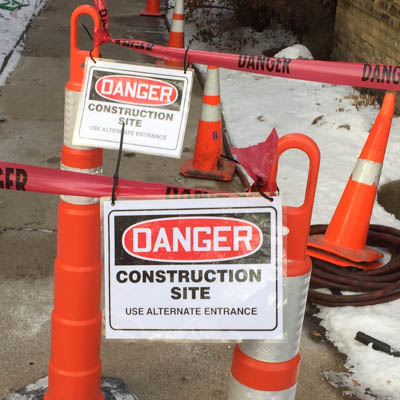Temporary Job Site Safety
In the masonry restoration industry we almost never have the luxury of working on unoccupied buildings. The job site is always at schools, condos, office, or church buildings. Buildings that have people living or working in them at all hours of the day. When working on buildings of this type, not only is the safety of the crew on our minds but the safety of the building occupants. Setting up temporary job site safety measures can accomplish both goals and even satisfy the government agencies that deal with safety from OSHA to the Fire Marshall.
Building Problems
First a little background information on the building. This building was built just over a 100 years ago. It used 16P finish nails as the brick ties. This is pretty common for the era. Over time if the building isn’t maintained water can get into the wall assembly. The roof leaks, caulking sealant breaks down and leaks, or the mortar joints weather to the point to allow water infiltration. Then either the brick ties rust, lintels rust and expand, or the freeze/thaw cycle starts moving the brick. Eventually what was once a very durable cladding becomes compromised and dangerous as the facade starts falling away from the building. A combination of these factors is what happened with this building. Water leaked in from the roof flashing and failed sealant, lintels over the basement windows rusted and expanded, and the brick was pushed up and out from the wall. Large gaps appeared around the window trim and more water at a faster rate infiltrated the assembly and accelerated the damage.
City Steps In
It doesn’t take an expert in masonry to see there is serious movement happening to the facade and that it could fall at any time. A concerned resident noticed the issue and called the city. The city stepped in and cited the building, ordering the owners to repair it before someone is seriously hurt or killed when the facade falls. Originally the city wanted jersey barriers installed but that would have required a crane to place and remove them. The compromise was to have us come in and fix it quickly.
Consulting with the Fire Marshall
A fire inspector met me out at the site and he discussed egress of the building from a whole building perspective. He was able to get access and evaluate the other exits and signage in a way that an exterior contractor can’t. He advised on proper signage for the exit door and even to cover up the interior lit exit sign so that in a power outage people wouldn’t attempt to follow the exit sign into an area of higher danger. Together we came up with a signage plan to not cut off the entry door entirely but to encourage users to use alternate routes.
We also chatted about building a guardrail around a window well that was now quite close to the walking path. Our enclosure covered up half of the exterior lighting so the well would also be hard to see in the dark compounding the danger. Erecting a guard rail as a temporary job site safety measure was absolutely the right call. It didn’t take long to build and would payback in spades with added safety of the site.
Benefits of using temporary job site safety measures
The first benefit is obvious, it protects you and the crew. Often times this is the first that guys are at the building so they are not familiar with the hazards yet. Just like most other industries, people are far and away the most valuable asset in construction. Protecting them should be at the forefront of planning and carrying out any project.
The second benefit is the protection of the building occupants. The occupants and users of any building are usually so comfortable with their surroundings that they often operate on automatic pilot going to and from their workstation or home. They may not be paying much attention to the construction activities in the area. Keeping them safe helps promote future work at the site.
The third benefit is the protection of the public. Many buildings we work on are surrounded by city sidewalks or the building serves the public directly. Protecting the part time users of the building and surrounding area helps to keep the company out of the newspaper and TV headlines. Also word of mouth is very powerful in construction. So many new jobs spawn because people have seen the work done on other buildings. If they see you not being safe they remember that when it comes time to hire… someone else.
The fourth benefit is one not often thought about and not nearly as important as protecting humans in the first three points. The benefit in using temporary job site safety measures and consulting with a safety authority like OSHA or a fire inspector is that it can protect the company. If the worst case scenario does happen and there is a fire in the building and someone loses their life it won’t be because of inadequate safety measures during construction.

